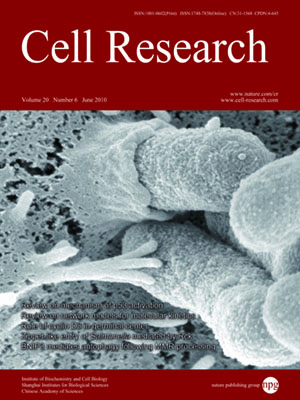
Volume 20, No 6, Jun 2010
ISSN: 1001-0602
EISSN: 1748-7838 2018
impact factor 17.848*
(Clarivate Analytics, 2019)
Volume 20 Issue 6, June 2010: 676-687
ORIGINAL ARTICLES
Hypoxia induces PGC-1α expression and mitochondrial biogenesis in the myocardium of TOF patients
Lingyun Zhu1,*, Qiang Wang2,*, Lin Zhang1,*, Zhixiang Fang1, Fang Zhao3, Zhiyuan Lv1, Zuguang Gu1, Junfeng Zhang1, Jin Wang1, Ke Zen1, Yang Xiang1, Dongjin Wang2 and Chen-Yu Zhang1
1Jiangsu Diabetes Center, State Key Laboratory of Pharmaceutical Biotechnology, School of Life Sciences, Nanjing University, Nanjing 210093, China
2Department of Thoracic Surgery, The Affiliated Drum Tower Hospital of Nanjing University Medical School, Nanjing 210008, China
3Department of Physiology, University of Toronto, Toronto, Ontario M5S 1A8, Canada
Correspondence: Chen-Yu Zhang, Dongjin Wang, Yang Xiang,(cyzhang@nju.edu.cn; gldjw@163.com; xiangy@nju.edu.cn;)
PGC-1α, a potent transcriptional coactivator, is the major regulator of mitochondrial biogenesis and activity in the cardiac muscle. The dysregulation of PGC-1α and its target genes has been reported to be associated with congenital and acquired heart diseases. By examining myocardium samples from patients with Tetralogy of Fallot, we show here that PGC-1α expression levels are markedly increased in patients compared with healthy controls and positively correlated with the severity of cyanosis. Furthermore, hypoxia significantly induced the expression of PGC-1α and mitochondrial biogenesis in cultured cardiac myocytes. Mechanistic studies suggest that hypoxia-induced PGC-1α expression is regulated through the AMPK signaling pathway. Together, our data indicate that hypoxia can stimulate the expression of PGC-1α and mitochondrial biogenesis in the cardiac myocytes, and this process might provide a potential adaptive mechanism for cardiac myocytes to increase ATP output and minimize hypoxic damage to the heart.
Cell Research (2010) 20:676-687. doi: 10.1038/cr.2010.46; published online 6 April 2010
FULL TEXT | PDF
Browse 2246


